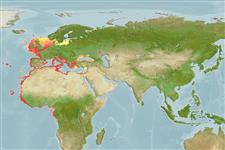Elasmobranchii (haaien en roggen) (sharks and rays) >
Myliobatiformes (Stingrays) >
Dasyatidae (Stingrays) > Dasyatinae
Etymology: Dasyatis: Greek, dasys = rough, dense (Ref. 45335).
More on author: Linnaeus.
Environment: milieu / climate zone / depth range / distribution range
Ecologie
marien; brak water demersaal; diepte 5 - 200 m (Ref. 6808), usually 20 - 35 m (Ref. 27000). Subtropical; 61°N - 17°S, 32°W - 42°E
East Atlantic and the Mediterranean and Black Sea, from the North Sea to Angola.
Lengte bij maturiteit / Grootte / Gewicht / Leeftijd
Maturity: Lm 54.3, range 41 - ? cm
Max length : 69.5 cm WD mannelijk / geslacht onbekend; (Ref. 123699); max. gepubliceerd gewicht: 10.2 kg (Ref. 123699)
A coastal species, which enters coastal lagoons, shallow bays and estuaries (Ref. 81259). Found over sandy and muddy bottoms, sometimes near rocky reefs (Ref. 12951). Feeds on bottom fishes, crustaceans and mollusks. Ovoviviparous, gestation period about 4 months and 4-7 young are produced. Wings marketed smoked, dried-salted, and also used for fishmeal and oil. Harmful to shellfish banks; dangerous to bathers and fishers due to its poisonous spine. Barbed poison spine is a modified denticle that can be 35cm long, shed occasionally and replaced (Ref. 35388). Maximum reported width about 150 cm (Ref. 81259).
Exhibit ovoviparity (aplacental viviparity), with embryos feeding initially on yolk, then receiving additional nourishment from the mother by indirect absorption of uterine fluid enriched with mucus, fat or protein through specialised structures (Ref. 50449). Distinct pairing with embrace (Ref. 205).
Bauchot, M.-L., 1987. Raies et autres batoides. p. 845-886. In W. Fischer, M.L. Bauchot and M. Schneider (eds.) Fiches FAO d'identificationpour les besoins de la pêche. (rev. 1). Mèditerranée et mer Noire. Zone de pêche 37. Vol. II. Commission des Communautés Européennes and FAO, Rome. (Ref. 3261)
Status op de Rode Lijst van het IUCN (Ref. 130435)
Gebruik door de mens
Visserij: commercieel; sportvis: ja
Tools
Speciale rapporten
Download XML
Internetbronnen
Estimates based on models
Preferred temperature (Ref.
123201): 9.7 - 26.1, mean 12.2 °C (based on 352 cells).
Fylogenetische diversiteitsindex (Ref.
82804): PD
50 = 0.5002 [Uniqueness, from 0.5 = low to 2.0 = high].
Bayesian length-weight: a=0.00741 (0.00443 - 0.01240), b=2.99 (2.85 - 3.13), in cm total length, based on LWR estimates for this species & (Sub)family-body (Ref.
93245).
Trofisch niveau (Ref.
69278): 4.1 ±0.63 se; based on food items.
Weerstandsvermogen (Ref.
120179): Zeer laag, minimale populatieverdubbelingstijd meer dan 14 jaar (Fec=4-7).
Fishing Vulnerability (Ref.
59153): Very high vulnerability (78 of 100).
Climate Vulnerability (Ref.
125649): Moderate to high vulnerability (55 of 100).
Nutrients (Ref.
124155): Calcium = 14.1 [1.7, 252.0] mg/100g; Iron = 0.696 [0.063, 8.002] mg/100g; Protein = 21.3 [18.7, 24.0] %; Omega3 = 0.263 [0.085, 0.750] g/100g; Selenium = 22 [4, 104] μg/100g; VitaminA = 7.14 [0.64, 75.50] μg/100g; Zinc = 0.591 [0.039, 6.718] mg/100g (wet weight);
